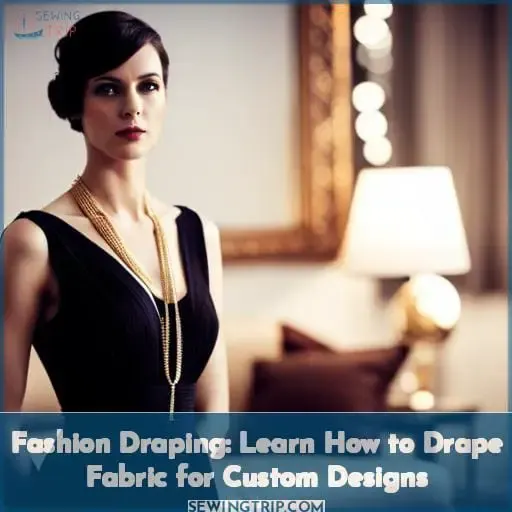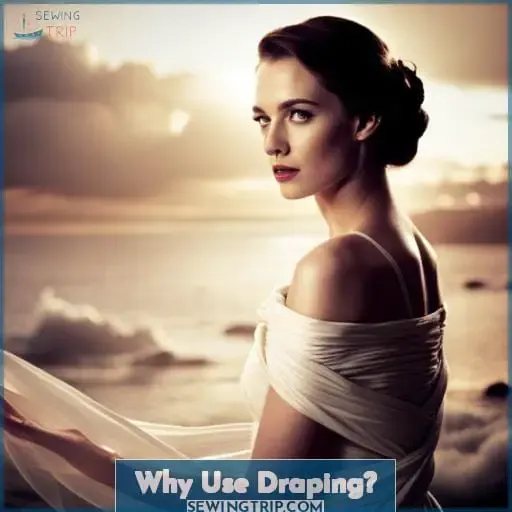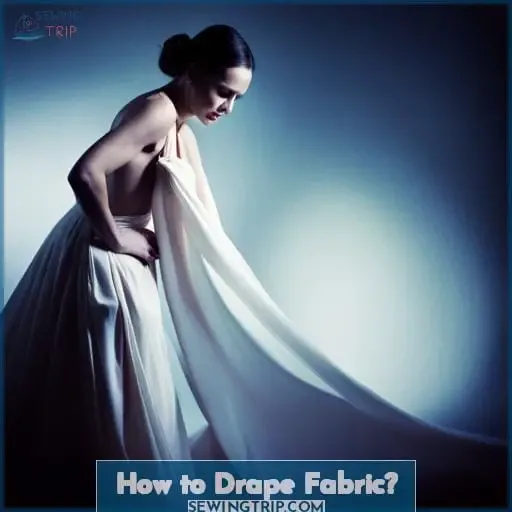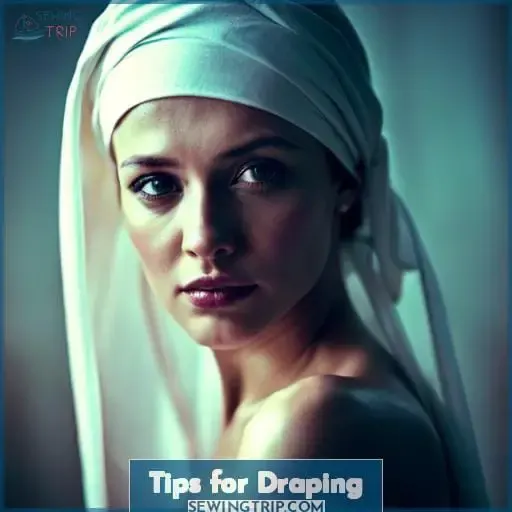This site is supported by our readers. We may earn a commission, at no cost to you, if you purchase through links.
 Want to create custom fashion designs that are perfectly tailored to your body? Learn the art of fashion draping and transform flat pieces of fabric into stunning garments.
Want to create custom fashion designs that are perfectly tailored to your body? Learn the art of fashion draping and transform flat pieces of fabric into stunning garments.
Table Of Contents
Key Takeaways
- Draping allows you to create custom designs by manipulating fabric directly on the dress form.
- Draping gives you an intuitive understanding of fit.
- Draping empowers designers to bring unique garments to life.
- There are a few basic techniques that are essential to draping.
What is Draping?
Draping is the process of positioning and pinning fabric on a dress form to develop the structure of a garment design. It’s an essential technique in fashion design that allows you to bring your ideas to life in three dimensions.
With draping, you can create custom designs by manipulating fabric directly on the dress form.
To begin draping, you’ll need some essential tools such as muslin fabric, which is commonly used for its affordability and ease of manipulation. The dress form acts as a model for your design, allowing you to see how it will fit and drape on the body.
Draping techniques involve shaping and molding the fabric using pins while considering factors like fit, balance, and overall aesthetics.
For beginners learning how to drape for fashion design, tutorials are available online along with resources such as books that provide step-by-step instructions on various draping techniques.
Why Use Draping?
Now that you understand the art of draping, it’s time to delve into why fashion designers should embrace this technique.
Draping allows you to create a basic pattern organically, designing directly on the dress form. By draping fabric on a three-dimensional body shape, you gain an intuitive understanding of fit and can immediately see how your designs will look and feel when worn.
It also gives you the freedom to experiment with different fabrics, exploring their behavior before committing them to paper patterns.
Draping empowers designers like you to bring unique garments to life by embracing creativity in every step of the process. Rather than relying solely on flat pattern making or pre-conceived notions, draping enables liberation from traditional methods and opens up new possibilities for innovative design solutions.
So take hold of your muslin fabric and let your imagination flow as you drape away towards creating stunning one-of-a-kind creations!
How to Drape Fabric?
To drape fabric for custom designs, you’ll start by preparing the fabric and positioning it on a dress form.
Here is how to drape fabric effectively:
- Choose the right muslin weight:
- Select muslin that has a similar weight to your fashion fabric. This will help ensure accuracy in draping.
- If you’re working with delicate or expensive fabrics, use cheaper alternatives such as lightweight cotton or polyester for draping purposes.
- Knitted fabrics have more stretch and flexibility, making them ideal for draping nonwoven materials like jersey or spandex.
When positioning the fabric on the dress form, be sure to:
- Mark seams, pleats, and other design details before unpinning it from the form.
- Check and true all curved lines to achieve precise measurements.
- Make sure all seams are matching perfectly before moving forward with pattern making.
Tips for Draping
When draping, start with a simple design and gradually add complexity.
Here are 3 tips for draping:
- Use pins to hold the fabric in place, but don’t pin it so tightly that it distorts the fabric.
- Mark all seams, pleats, and other design details on the fabric before unpinning.
- True all curved lines by pinning the fabric in place and then steaming it with an iron.
Frequently Asked Questions (FAQs)
What are the different types of dress forms?
There are many different types of dress forms, each designed to fit a specific body type.
You need to choose the right dress form for your body type in order to create garments that fit perfectly.
What are the different types of muslin?
Muslin is an inexpensive, unbleached, loosely woven cotton fabric.
It’s typically used for draping and making patterns.
There are many different types of muslin, each with its own unique properties.
What are the different types of pins used for draping?
There are many different types of pins used for draping, including:
- Straight pins
- Safety pins
- Bodkin pins
What are the different types of marking tools used for draping?
There are many different types of marking tools used for draping, including:
- Pencils
- Chalk
- Tracing paper
- Dressmaker’s carbon
What are the different types of pressing tools used for draping?
You will need a variety of pressing tools to create the perfect drapes for your home.
- An iron
- A steamer
- A pressing board
- A sleeve board
Conclusion
With fashion draping, you can take control of your designs and create one-of-a-kind garments that flatter your figure and your style.










